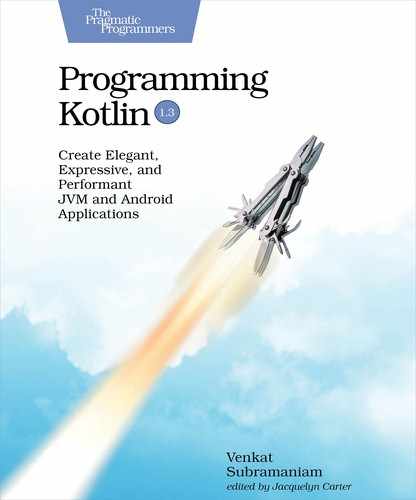Closures and Lexical Scoping
Functional programmers talk about lambdas and closures. Many programmers use those two terms interchangeably, which is acceptable, as long as we know the difference and can discern which one we’re using based on the context. Let’s take a closer look at how lambdas bind to variables and how that relates to the concept of closures.
A lambda is stateless; the output depends on the values of the input parameters. For example, the output of the following lambda is twice the value of the given parameter:
| | val doubleIt = { e: Int -> e * 2 } |
Sometimes we want to depend on external state. Such a lambda is called a closure—that’s because it closes over the defining scope to bind to the properties and methods that aren’t local. Let’s turn the previous lambda into a closure.
| | val factor = 2 |
| | |
| | val doubleIt = { e: Int -> e * factor } |
In this version, e is still the parameter. But within the body, the variable or property factor isn’t local. The compiler has to look in the defining scope of the closure—that is, where the body of the closure is defined—for that variable. If it doesn’t find it there, the compiler will have to continue the search in the defining scope of the defining scope, and so on. This is called lexical scoping.
In our example, the compiler binds the variable factor within the body of the closure to the variable right above the closure—that is, val factor = 2.
We used lexical scoping earlier in Function Returning Functions, and it felt so natural that it may have gone unnoticed. Here’s the relevant code from that section, repeated for your convenience:
| | fun predicateOfLength(length: Int): (String) -> Boolean { |
| | return { input: String -> input.length == length } |
| | } |
The lambda being returned has a parameter named input. Within the body of the lambda we compare the value of the length property of this input parameter with the value in the length variable. But, the variable length isn’t part of the lambda—it’s from the closure’s lexical scope, which happens to be the parameter passed to the predicateOfLength() function.
Mutability is taboo in functional programming. However, Kotlin doesn’t complain if from within a closure we read or modify a mutable local variable. In the earlier example, the variable factor is immutable since it’s defined as a val. If we change it to a var—that is, turn it into a mutable variable—then potentially we may modify factor from within the closure. The Kotlin compiler won’t warn in this case, but the result may surprise or, at the very least, confuse the reader.
In the following code we transform values in two collections, one created using listOf() and the other created using sequenceOf(). After that, we modify the value in the variable factor and, finally, print the values of the transformed collections. Without running the code, try guessing the output of the code.
| | var factor = 2 |
| | |
| | val doubled = listOf(1, 2).map { it * factor } |
| | val doubledAlso = sequenceOf(1, 2).map { it * factor } |
| | |
| | factor = 0 |
| | |
| | doubled.forEach { println(it) } |
| | doubledAlso.forEach { println(it) } |
Is it 2, 4, 2, 4 on separate lines, 0, 0, 0, 0, or 2, 4, 0, 0?
It’s certainly not worth the trouble thinking through the different behaviors of list vs. sequence (which we’ll cover in Chapter 11, Internal Iteration and Lazy Evaluation), even though the structure of the code to transform the two collections are so similar. Using mutable variables from within a closure is often a source of error and should be avoided. Keep closure as pure functions to avoid confusion and to minimize errors—see Prefer val over var.
